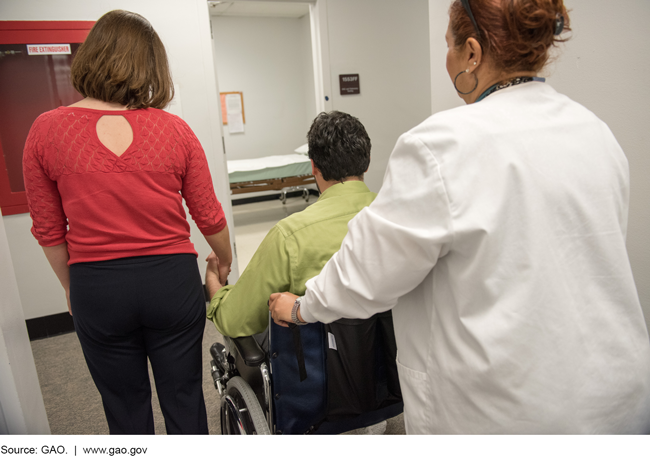Medicare: Payments for Certain Long-Term Care Hospitals that Specialize in Spinal Cord Treatment
Fast Facts
After an injury or illness, Medicare patients who need long-term care may be able to get that care at different types of facilities.
Medicare payments to long-term care hospital facilities were typically higher than payments to other facilities because long-term care can take more resources, such as specialized equipment and staff.
A 2013 law phased in lower Medicare payments to long-term care hospitals for patients who could be treated in less costly facilities. Two hospitals focusing on spinal cord care qualified for an exception to the new payments in fiscal years 2018-19. We reviewed the effects of the exception.

Photo of a woman holding hands with a man in a wheelchair as a health care worker pushes him toward a room in a clinic.
Highlights
What GAO Found
Spinal cord injuries may result in secondary complications that often lead to decreased functional independence and quality of life. The 21st Century Cures Act changed how Medicare pays certain long-term care hospitals (LTCH) that provide spinal cord specialty treatment. For these hospitals, the act included a temporary exception from how Medicare pays other LTCHs. Two LTCHs—Craig Hospital in Englewood, Colorado and Shepherd Center in Atlanta, Georgia—have qualified for this exception. GAO found that most Medicare beneficiaries treated at these two hospitals typically receive specialized care for multiple chronic conditions and other long-term complications that develop after initial injuries, such as pressure ulcers that can result in life-threatening infection. The two hospitals also provide specialty care for acquired brain injuries, such as traumatic brain injuries.
GAO's simulations of Medicare payments to these two hospitals using claims data from two baseline years—fiscal years 2013 and 2016—illustrate potential effects of payment policies. LTCHs are paid under a two-tiered system for care provided to beneficiaries: they receive the LTCH standard federal payment rate—or standard rate—for certain patients discharged from the LTCH, and a generally lower rate—known as a “site-neutral” rate—for all other discharges. Under the temporary exception, Craig Hospital and Shepherd Center receive the standard rate for all discharges during fiscal years 2018 and 2019. Assuming their types of discharges remain the same as in fiscal years 2013 and 2016, GAO's simulations of Medicare payments in the baseline years indicate:
Most of the discharges we examined would not qualify for the standard rate, if the exception did not apply.
Medicare payments would generally decrease under fiscal year 2020 payment policy, once the exception expires.
However, the actual effects of Medicare's payment policies on these two hospitals could vary based on factors, including the severity of patient conditions (e.g., Medicare payment is typically higher for more severe injuries), and whether hospitals' discharges meet criteria for the standard rate.
Similarities and differences may exist between the two qualifying hospitals and other facilities that treat Medicare patients with spinal cord and brain injuries. Patients with spinal cord and brain injuries may receive care in other LTCHs, but GAO found that most Medicare beneficiaries at these other LTCHs are treated for conditions other than spinal cord and brain injuries. Certain inpatient rehabilitation facilities (IRF) also provide post-acute rehabilitation services to patients with spinal cord and brain injuries. While data limitations make a direct comparison between these facilities and the two qualifying hospitals difficult, GAO identified some similarities and differences. For example, officials from some IRFs we interviewed reported providing several of the same programs and services as the two qualifying hospitals to medically complex patients, but the availability of services and complexity of patients varied. Among other reasons, the different Medicare payment requirements that apply to LTCHs and IRFs affect the types of services they provide and the patients they treat.
Why GAO Did This Study
The Centers for Medicare & Medicaid Services pays LTCHs for care provided to Medicare beneficiaries. There were about 400 LTCHs across the nation in 2016.
The 21st Century Cures Act included a provision for GAO to examine certain issues pertaining to LTCHs. This report examines (1) the health care needs of Medicare beneficiaries who receive services from the two qualifying hospitals; (2) how Medicare LTCH payment polices could affect the two qualifying hospitals; and (3) how the two qualifying hospitals compare with other LTCHs and other facilities that may treat Medicare patients with similar conditions.
GAO analyzed the most recently available Medicare claims and other data for the two qualifying hospitals and other facilities that treat patients with spinal cord injuries. GAO also interviewed HHS officials and stakeholders from the qualifying hospitals, other facilities that treat spinal cord patients, specialty associations, and others.
GAO provided a draft of this report to HHS. HHS provided technical comments, which were incorporated as appropriate. We also provided the two qualifying hospitals summaries of information we collected from them, to confirm the accuracy of statements included in our draft report. We incorporated their comments, as appropriate.
For more information, contact Jessica Farb at (202) 512-7114 or farbj@gao.gov.
